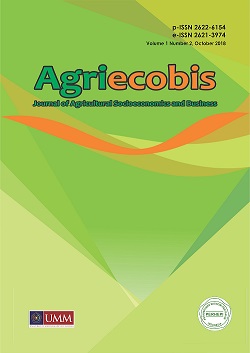Analisis Location Quotient (LQ) Komoditas Cabai di Kabupaten Kediri
DOI:
https://doi.org/10.22219/agriecobis.Vol1.No2.11-22Keywords:
Cabai, Sektor Basis, Analisis LQAbstract
Chili is vegetables that have an important role in agriculture in Indonesia. Generally, the amount of chili production is determined by the harvested area and productivity of the land. Chili is one of the main horticulture products in Indonesia. Kediri District is potential as a center of chili’s production. According to Ibrahim, 2012 there are four major sub-district in the production of chili commodities, such as Kepung District, Puncu District, Papar District, and Pagu District. The determination of a commodity to be a superior commodity in Kediri District based on the consideration that not all vegetable commodities are suitable to be developed in all places. The purpose of this research is 1) Knowing the growth of chili’s production, 2) Analyze the Location Quotient of chili in Kediri District, 3) Analyze the Location Quotient of cayenne in Kediri District. This research is using secondary data. This research data was analyzed by Location Quotient (LQ). This research shows that the growth of harvested area has fluctuated every year. Chili’s production has fluctuated during 2014-2016. Cayenne’s production has fluctuated during 2014-2016. Mojo sub-district is basis area of harvested area and chili’s production for last three years. Pagu District sub-district is basis area of harvested area and cayenne’s production for last three years.
Downloads
References
Azhar. 2001. Analisis Sektor Basis dan Non Basis di Provinsi Nanggroe Aceh Darussalam. , 1–9 Firdaus, Muhammad, et.al. 2009. Penentuan Komoditas Pertanian Unggulan Di Kabupaten Jember. Jurnal Sosial Ekonomi Pertanian 3(1):33–39. Hendayana, Rachmat. 2003. Aplikasi Metode Location Quotient (LQ) Dalam Penentuan Komoditas Unggulan Nasional. Jurnal Informatika Pertanian 12:1–21. Ibrahim, JT. 1995. Buku Diktat Metode Penelitian Sosial Ekonomi Pertanian. Malang: UMM. Ibrahim, JT. 2012. Study on Market Appraisal and Value Chain Development Of Chilli Products In East Java. Riset Manajemen 0–52. Kurniawan, Dicky. 2010. Alternatif Pengembangan Ekonomi Lokal Di Kota Pontianak Studi Kasus Pertanian Lidah Buaya. Kalimantan Barat. Jurnal Perencanaan dan Wilayah Kota. Vol. 21 No.1 Kurniawan, Rony. 2014. Aplikasi Location Quotient ( LQ ) Sebagai Metode Penentuan Komoditas Palawija Unggulan. Kediri. Jurnal Riset Ekonomi dan Bisnis. Vol 1 No. 2 Prajnanta, F. 2007. Agribisnis Cabai Hibrida. Jakarta: Penebar Swadaya Raharjo, S., Widiatmaka, dan U.Sudadi. 2015. Analisis Kesesuaian Lahan Untuk Komoditas Sayuran Unggulan Di Kabupaten Batang. Jurnal Pengelolaan Sumberdaya Alam Dan Lingkungan 5(1):33–41 Sugiyono. 2010. Metode Penelitian Pendidikan Pendekatan Kuantitatif, kualitatif, dan R&D. Bandung: Alfabeta Suparman., 2006. Bercocok Tanam Cabai. Jakarta: Azka-Press Suwandi. 2015. Outlook Cabai 2015. Pusat Data Dan Sistem Informasi Pertanian, 79 Tarigan, S dan W. Wiryanta., 2003 Bertanam Cabai Hibrida Secara Intensif. Jakarta : Agromedia Pustaka, , Hal : 16 – 17, 33, 90 – 92 Tindall, H. D., 1983. Vegetable In The Tropics. Mac Milan Press Ltd., London. Yulianto, Dwi Puspita and Eko Budi Santoso. 2013. Identifikasi Potensi Komoditas Unggulan Pada Koridor Jalan Lintas Selatan Jatim Di Kabupaten TulungagungTrenggalek. Jurnal Teknik POMITS 2(2).
Downloads
Published
How to Cite
Issue
Section
License
Authors who publish with Agriecobis : Journal of Agricultural Socioeconomics and Business agree to the following terms:
- For all articles published in Agriecobis : Journal of Agricultural Socioeconomics and Business, copyright is retained by the authors. Authors give permission to the publisher to announce the work with conditions. When the manuscript is accepted for publication, the authors agree to automatic transfer of the publishing right to the publisher.
- Authors retain copyright and grant the journal right of first publication with the work simultaneously licensed under a Creative Commons Attribution-ShareAlike 4.0 International License that allows others to share the work with an acknowledgment of the work's authorship and initial publication in this journal.
- Authors are able to enter into separate, additional contractual arrangements for the non-exclusive distribution of the journal's published version of the work (e.g., post it to an institutional repository or publish it in a book), with an acknowledgment of its initial publication in this journal.
- Authors are permitted and encouraged to post their work online (e.g., in institutional repositories or on their website) prior to and during the submission process, as it can lead to productive exchanges, as well as earlier and greater citation of published wor (See The Effect of Open Access).

This work is licensed under a Creative Commons Attribution-ShareAlike 4.0 International License.







